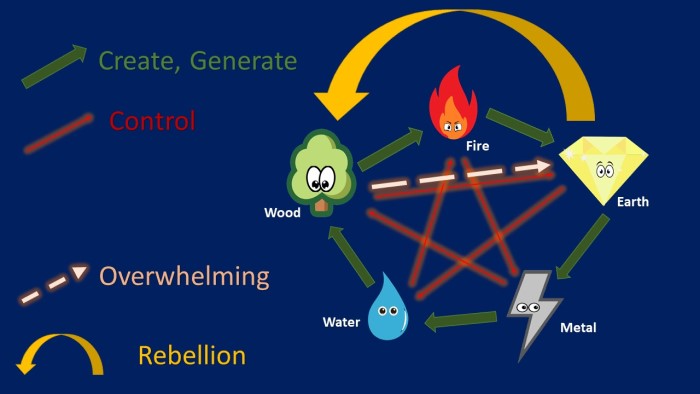Lesson 7: Five Elements
The Relationship between Yin-Yang and the Five Primordial Elements

The five elements theory derives from the Yin-Yang principle and changes between the proportions. The image above describes very well the definition or formation of the five elements according to the increase respectively the decrease of one of the forces (yin or yang). The earth element is in the center, defining the perfect balance between Yin and Yang present at the center.
That is one more reason to value the principle of centering while we are training our mind and body. The verb concentration comes from the idea of going back to the center of a circle.
Relationships Between the Five Phases
These phases do not exist in isolation from each other, but influence each other in a constant, dynamic interaction.

Deeper understanding of the how the energy flows between elements, gives us the basic knowledge on how to treat any imbalance in the body.
There are four types of interactions possible between the five phases.
Create
This is the main cycle, also called “mother-child”, because it describes the nurturing process from one element to another. For example, water nourish the wood (plants), wood creates fire, fire turn into ashes (Earth).
This cycle is considered the main one and also represents the time direction from one season to another. Our Universe is a combination of space and time. Time flows from past to the future, through the present.
Control
This is also called the restraining cycle. It keeps the phases in check when one of them grows too powerful. For example, fire controls metals, meaning it melts it.
When the restraining cycle breaks down, the resulting disharmony can be viewed in terms of “rebellion” or “overwhelming”. The creation and control cycles reflect harmonious courses of events, whereas the overwhelming cycle and the rebellion cycle represent disharmonious events.
Overwhelming
The overwhelming cycle is an abnormal exaggeration of the restrainig cycle, where one of the phases is weakened, causing the phase that under normal circumstances would restrain it to invade and weaken it further.
Rebellion
The rebellion cycle is a reversal of the restraining relationship, where one
of the five phases is disproportionately strong and rebels against the phase that should normally restrain it.
For a Qi Gong practitioner, the five phases, in association with their cycles, provide the tools for explaining tendencies and relationships between different organs and how to treat them. The concept of five phases plays an important role in classifying foods, herbs and different Qi Gong routines.
In the Qi Gong Basic Level we are learning about the elemental phases and how they interact with each other, which forms the basis for self-diagnosis and treatment which will be learned in the next levels.
Learning well the elements will be also useful in balancing nutrition as well in understanding the dynamic of life relationships with other people. Provided that everything can be considered part of one of the elements (as well as Yin or Yang), balance may be found easier by adding or substracting one or more elemental type of energy.
